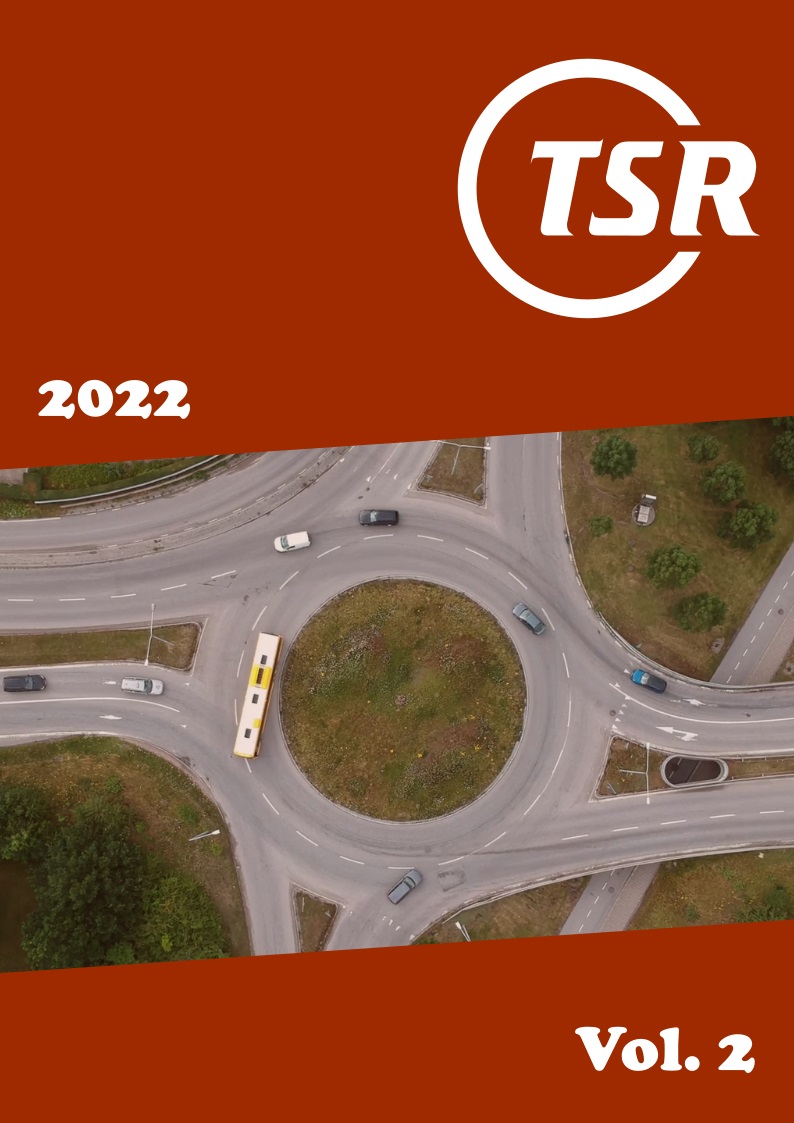Safe speeds: fatality and injury risks of pedestrians, cyclists, motorcyclists, and car drivers impacting the front of another passenger car as a function of closing speed and age
DOI:
https://doi.org/10.55329/vfma7555Keywords:
active travel, injury risk function, Safe System, speed limit, Vision ZeroAbstract
As crash speed increases, so does the probability of injury. The vulnerability of different road users varies greatly, in part due to differences in their protective equipment. Therefore, for the same speed, their injury probabilities are different. The objective of this study is to define injury risk curves, mathematical relations between closing speed (the relative speed between two crash partners) and injury outcome, for different road users. These risk curves can be used to rank road user vulnerability and define safe speeds, i.e. speeds not exceeding tolerable injury probabilities. Crashes involving pedestrians, cyclists, motorcyclists, and car drivers impacting the front of another passenger car (i.e. frontal impacts from the other car’s perspective) were extracted from the German in-depth accident study (GIDAS). The injuries were modelled as a function of closing speed and road user age using a weighted binary logistic regression. In accordance with the Abbreviated Injury Scale 2015 revision, three injury severities were modelled: at-least-moderate injury severities, at-least-serious injury severities, and fatal injuries. The constructed risk curves predicted injury outcomes with an average Area under the Curve ranging from 0.66 to 0.94 in cross-validation. A 10% risk of sustaining at-least-serious injuries corresponds to a closing speed of 29 km/h for pedestrians, 44 km/h for cyclists, 48 km/h for motorcyclists, and 112 km/h for car drivers. If a 10% risk of serious injury is acceptable, the closing speeds can be translated into safe speed limits of 25 km/h for cars with pedestrian encounters; 20 to 25 km/h for cyclists, motorcyclists, and cars when they encounter each other; and 55 km/h for cars in head-on impacts. These safe speeds align with current speed limits of 20 to 30 km/h in urban centers but bring into question the current practices of much higher speed limits on rural roads shared by bicycles, motorcycles, and cars. However, safe speed limits could be increased (maintaining a 10% serious injury risk) if road users have more protective equipment and Automated Emergency Braking reliably reduces impact speeds in all crash types.
Downloads
References
AAAM (2016) The Abbreviated Injury Scale. Association for the Advancement of Automotive Medicine. 2015 revision: https://www.aaam.org/bookstore/ais-dictionary
Academic Expert Group (2019) Saving Lives Beyond 2020. Swedish Transport Administration. TRV 2019:209: https://www.roadsafetysweden.com/contentassets/c65bb9192abb44d5b26b633e70e0be2c/200113_final-report-single.pdf
Bahouth, G., J. Graygo, K. Digges, C. Schulman, P. Baur (2014) The Benefits and Tradeoffs for Varied High-Severity Injury Risk Thresholds for Advanced Automatic Crash Notification Systems. Traffic Injury Prevention 15 (Supplement 1), 134-140. DOI: https://doi.org/10.1080/15389588.2014.936011
Bahrololoom, S., W. Young, D. Logan (2020) Modelling injury severity of bicyclists in bicycle-car crashes at intersections. Accident Analysis & Prevention 144, 105597. DOI: https://doi.org/10.1016/j.aap.2020.105597
Bareiss, M., H. C. Gabler (2020) Estimating near side crash injury risk in best performing passenger vehicles in the United States. Accident Analysis & Prevention 138, 105434. DOI: https://doi.org/10.1016/j.aap.2020.105434
BMDV (2021) Germany 2030 - a cycling nation. National Cycling Plan 3.0. Federal Ministry for Digital and Transport: https://www.bmvi.de/SharedDocs/DE/Anlage/StV/nationaler-radverkehrsplan-3-0-en.pdf
Davis, A. L., D. Obree (2020) Equality of restraint: Reframing road safety through the ethics of private motorised transport. Journal of Transport & Health 19, 100970. DOI: https://doi.org/10.1016/j.jth.2020.100970
Davis, G. A. (2001) Relating Severity of Pedestrian Injury to Impact Speed in Vehicle-Pedestrian Crashes: Simple Threshold Model. Transportation Research Record 1773 (1), 108-113. DOI: https://doi.org/10.3141/1773-13
Destatis (2019) Verkehrsunfälle. Statistisches Bundesamt. Fachserie 8 Reihe 7: https://www.destatis.de/DE/Themen/Gesellschaft-Umwelt/Verkehrsunfaelle/Publikationen/Downloads-Verkehrsunfaelle/verkehrsunfaelle-jahr-2080700197004.pdf
Ding, C., M. Rizzi, J. Strandroth, U. Sander, N. Lubbe (2019) Motorcyclist injury risk as a function of real-life crash speed and other contributing factors. Accident Analysis & Prevention 123, 374-386. DOI: https://doi.org/10.1016/j.aap.2018.12.010
Doecke, S. D., M. R. J. Baldock, C. N. Kloeden, J. K. Dutschke (2020) Impact speed and the risk of serious injury in vehicle crashes. Accident Analysis & Prevention 144, 105629. DOI: https://doi.org/10.1016/j.aap.2020.105629
Dozza, M., R. Schindler, G. Bianchi-Piccinini, J. Karlsson (2016) How do drivers overtake cyclists? Accident Analysis & Prevention 88, 29-36. DOI: https://doi.org/10.1016/j.aap.2015.12.008
EC (2018) Annual Accident Report. European Commission, Directorate General for Transport
ECMT (2004) National Policies to Promote Cycling. European Conference of Ministers of Transport: http://www.internationaltransportforum.org/pub/pdf/04Cycling.pdf
ETSC (2020) How safe is walking and cycling in Europe? European Transport Safety Council. PIN Flash Report 38: https://etsc.eu/wp-content/uploads/PIN-Flash-38_FINAL.pdf
Eugensson, A., J. Ivarsson, A. Lie, C. Tingvall (2011) Cars are Driven on Roads, Join Visions and Modern Technologies Stress the Need for Co-operation. 22nd International Technical Conference on the Enhanced Safety of Vehicles (ESV), Washington DC, USA
Forman, J., G. S. Poplin, C. G. Shaw, T. L. McMurry, K. Schmidt, J. Ash, C. Sunnevang (2019) Automobile injury trends in the contemporary fleet: Belted occupants in frontal collisions. Traffic Injury Prevention 20 (6), 607-612. DOI: https://doi.org/10.1080/15389588.2019.1630825
Forman, J. L., T. L. McMurry (2018) Nonlinear models of injury risk and implications in intervention targeting for thoracic injury mitigation. Traffic Injury Prevention 19 (sup2), S103-S108. DOI: https://doi.org/10.1080/15389588.2018.1528356
Gabauer, D. J., H. C. Gabler (2006) Comparison of delta-v and occupant impact velocity crash severity metrics using event data recorders. Annual proceedings/association for the advancement of automotive medicine: https://www.ncbi.nlm.nih.gov/pmc/articles/PMC3217488/
Götschi, T., J. Garrard, B. Giles-Corti (2015) Cycling as a Part of Daily Life: A Review of Health Perspectives. Transport Reviews 36 (1), 45-71. DOI: https://doi.org/10.1080/01441647.2015.1057877
Hautzinger, H., M. Pfeiffer, J. Schmidt (2004) Expansion of GIDAS Sample Data to the Regional Level. Proceedings of Expert Symposium on Accident Research
He, H., Y. Ma (Eds.) (2013) Imbalanced learning: foundations, algorithms, and applications. John Wiley & Sons. ISBN 978-1-118-07462-6 DOI: https://doi.org/10.1002/9781118646106.ch1
Hu, J., K. D. Klinich (2015) Toward designing pedestrian-friendly vehicles. International Journal of Vehicle Safety 8 (1), 22. DOI: https://doi.org/10.1504/IJVS.2015.066272
Hussain, Q., H. Feng, R. Grzebieta, T. Brijs, J. Olivier (2019) The relationship between impact speed and the probability of pedestrian fatality during a vehicle-pedestrian crash: A systematic review and meta-analysis. Accident Analysis & Prevention 129, 241-249. DOI: https://doi.org/10.1016/j.aap.2019.05.033
Isaksson-Hellman, I., J. Werneke (2017) Detailed description of bicycle and passenger car collisions based on insurance claims. Safety Science 92, 330-337. DOI: https://doi.org/10.1016/j.ssci.2016.02.008
ISO (2020) Road vehicles—Traffic accident analysis— Part 1: Vocabulary. International Organization for Standardization. 12353-1:2020: https://www.iso.org/standard/68075.html
ITF/OECD (2008) Towards Zero. Ambitious road safety targets and the Safe System approach. International Transport Forum: http://www.internationaltransportforum.org/Pub/pdf/08TowardsZeroE.pdf
ITF/OECD (2018) Road Safety Annual Report 2018. International Transport Forum: https://www.itf-oecd.org/road-safety-annual-report-2018
ITF/OECD (2019) Road Safety in European Cities: Performance Indicators and Governance Solutions. International Transport Forum Policy Papers: https://www.itf-oecd.org/road-safety-european-cities
Jacobsen, P. L., F. Racioppi, H. Rutter (2009) Who owns the roads? How motorised traffic discourages walking and bicycling. Injury Prevention 15 (6), 369-373. DOI: https://doi.org/10.1136/ip.2009.022566
Jeppsson, H., N. Lubbe (2020) Simulating Automated Emergency Braking with and without Torricelli Vacuum Emergency Braking for cyclists: Effect of brake deceleration and sensor field-of-view on accidents, injuries and fatalities. Accident Analysis & Prevention 142, 105538. DOI: https://doi.org/10.1016/j.aap.2020.105538
Jurewicz, C., A. Sobhani, J. Woolley, J. Dutschke, B. Corben (2016) Exploration of Vehicle Impact Speed – Injury Severity Relationships for Application in Safer Road Design. Transportation Research Procedia 14, 4247-4256. DOI: https://doi.org/10.1016/j.trpro.2016.05.396
Kleinbaum, D. G., K. Dietz, M. Gail, M. Klein, M. Klein (2002) Logistic Regression. Springer-Verlag
Kullgren, A., A. Axelsson, H. Stigson, A. Ydenius (2019) Developments in Car Crash Safety and Comparisons Between Results From Euro NCAP Tests and Real-World Crashes. 26th International Technical Conference on the Enhanced Safety of Vehicles (ESV), Eindhoven, Netherlands: https://www-esv.nhtsa.dot.gov/Proceedings/26/26ESV-000291.pdf
Larsson, P., S. W. A. Dekker, C. Tingvall (2010) The need for a systems theory approach to road safety. Safety Science 48 (9), 1167-1174. DOI: https://doi.org/10.1016/j.ssci.2009.10.006
Liers, H. (2018) Traffic Accident Research in Germany and the German In-Depth Accident Study (GIDAS). ACMA-SIAM-VDA Conference On Safer & Sustainable Road Transportation, New Delhi, India: https://www.vufo.de/wp-content/uploads/2021/02/181120_SIAM_ACMA_VDA_Conference_Liers_GIDAS-Presentation.pdf
NHTSA (2020) Overview of Motor Vehicle Crashes in 2019. National Highway Traffic Safety Administation's National Center for Statistics and Analysis. DOT HS 813 060: https://crashstats.nhtsa.dot.gov/Api/Public/ViewPublication/813060
Niebuhr, T., M. Junge (2017) Detection of the toughest: Pedestrian injury risk as a smooth function of age. Traffic Injury Prevention 18 (5), 537-543. DOI: https://doi.org/10.1080/15389588.2016.1264580
Niewöhner, W., F. Roth, J. Gwehenberger, C. Gruber, M. Kuehn, R. Sferco, C.-H. Pastor, U. Nagel, M. Stanzel (2011) Proposal for a Test Procedure of Assistance Systems Regarding Preventive Pedestrian Protection. 22nd International Technical Conference on the Enhanced Safety of Vehicles (ESV), Washington, DC, USA
Nilsson, P., H. Stigson, M. Ohlin, J. Strandroth (2017) Modelling the effect on injuries and fatalities when changing mode of transport from car to bicycle. Accident Analysis & Prevention 100, 30-36. DOI: https://doi.org/10.1016/j.aap.2016.12.020
Nishimoto, T., K. Mukaigawa, S. Tominaga, T. Kiuchi (2015) Development of AACN algorithm for pedestrian and cyclist. Transactions of Society of Automotive Engineers of Japan 46 (6), 1123-1129.
Otte, D., C. Krettek, H. Brunner, H. Zwipp (2003) Scientific approach and methodology of a new in-depth investigation study in Germany called GIDAS. 18th International Technical Conference on the Enhanced Safety of Vehicles (ESV), Nagoya, Japan
Pfeiffer, M., J. Schmidt (2006) Statistical and methodological foundations of the GIDAS accident survey system. Expert Symposium on Accident Research (ESAR), Hannover, Germany: https://bast.opus.hbz-nrw.de/opus45-bast/frontdoor/deliver/index/docId/449/file/Statistical_and_Methodological.pdf
Pucher, J., R. Buehler (2010) Walking and Cycling for Healthy Cities. Built Environment 36 (4), 391-414. DOI: https://doi.org/10.2148/benv.36.4.391
Rosén, E. (2013) Autonomous emergency braking for vulnerable road users. International Research Council on the Biomechanics of Injury (IROCBI) Conference, Gothenburg, Sweden: http://www.ircobi.org/wordpress/downloads/irc13/default.htm
Rosén, E., U. Sander (2009) Pedestrian fatality risk as a function of car impact speed. Accident Analysis & Prevention 41 (3), 536-542. DOI: https://doi.org/10.1016/j.aap.2009.02.002
Rosén, E., U. Sander (2010) Influence of impact speed estimation errors on pedestrian fatality risk curves. Expert Symposium on Accident Research (ESAR), Hannover, Germany: https://bast.opus.hbz-nrw.de/opus45-bast/frontdoor/deliver/index/docId/518/file/Influence_of_impact_speed_estimation_errors.pdf
Rosén, E., H. Stigson, U. Sander (2011) Literature review of pedestrian fatality risk as a function of car impact speed. Accident Analysis & Prevention 43 (1), 25-33. DOI: https://doi.org/10.1016/j.aap.2010.04.003
Schmitt, K.-U., P. F. Niederer, D. S. Cronin, B. Morrison Iii, M. H. Muser, F. Walz (2019) Trauma Biomechanics: An Introduction to Injury Biomechanics. Springer. ISBN 978-3-030-11659-0. DOI: https://doi.org/10.1007/978-3-030-11659-0
Schramm, S. (2011) Methode zur Berechnung der Feldeffektivität integraler Fußgängerschutzsysteme. PhD thesis. Technical University Munich: https://mediatum.ub.tum.de/doc/1072193/1072193.pdf
Spitzhüttl, D. I. F., D. I. H. Liers (2016) Methodik zur Erstellung von Verletzungsrisikofunktionen aus Realunfalldaten
Stigson, H., A. Kullgren, E. Rosén (2012) Injury risk functions in frontal impacts using data from crash pulse recorders. Annals of Advances in Automotive Medicine/Annual Scientific Conference: https://www.ncbi.nlm.nih.gov/pmc/articles/PMC3503411/
Strandroth, J., S. Sternlund, A. Lie, C. Tingvall, M. Rizzi, A. Kullgren, M. Ohlin, R. Fredriksson (2014) Correlation Between Euro NCAP Pedestrian Test Results and Injury Severity in Injury Crashes with Pedestrians and Bicyclists in Sweden. 58th Stapp Car Crash Conferences. DOI: https://doi.org/10.4271/2014-22-0009
Tarriere, C. (1995) Children are not miniature adults. International Research Council on the Biomechanics of Injury (IRCOBI), Brunnen, Switzerland: http://www.ircobi.org/wordpress/downloads/irc1995/default.htm
Tight, M., M. Page, A. Wolinski, R. Dixey (1998) Casualty reduction or danger reduction: conflicting approaches or means to achieve the same ends? Transport Policy 5 (3), 185-192. DOI: https://doi.org/10.1016/S0967-070X(98)00016-X
Trafikverket (2016) Trafikverkets årsredovisning 2016. Swedish Transport Administration. 2017:095: https://trafikverket.ineko.se/Files/sv-SE/19581/Ineko.Product.RelatedFiles/2017_095_TRV_%C3%85rsredovisning_2016.pdf
Wisch, M., M. Lerner, J. Kovaceva, A. Bálint, I. Gohl, A. Schneider, J. Juhasz, M. Lindman (2017a) Car-to-cyclist crashes in Europe and derivation of use cases as basis for test scenarios of next generation advanced driver assistance systems – Results from PROSPECT. 25th International Technical Conference on the Enhanced Safety of Vehicles (ESV), Detroit, USA: https://www-esv.nhtsa.dot.gov/Proceedings/25/25ESV-000396.pdf
Wisch, M., M. Lerner, E. Vukovic, D. Hynd, A. Fiorentino, A. Fornells (2017b) Injury Patterns of Older Car Occupants, Older Pedestrians or Cyclists in Road Traffic Crashes with Passenger Cars in Europe – Results from SENIORS. International Research Council on Biomechanics of Injury (IRCOBI) Conference, Antwerp, Belgium: http://www.ircobi.org/wordpress/downloads/irc17/pdf-files/17.pdf
Downloads
Published
How to Cite
Issue
Section
License
Copyright (c) 2022 Nils Lubbe, Yi Wu, Hanna Jeppsson

This work is licensed under a Creative Commons Attribution 4.0 International License.










